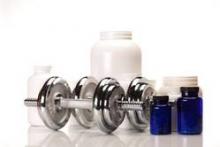Serious liver injury from herbal and dietary supplements – including those used by bodybuilders – has risen significantly over the past decade.
According to findings from a review, herbal supplement–related injures increased from 2% to 20% of all nonacetaminophen drug-related liver injuries. Injuries from bodybuilding supplements rose from 2% to 8%, while those related to nonbodybuilding supplements increased from 5% to 12%, Dr. Victor J. Navarro, chair of the hepatology division at the Einstein Medical Center, Philadelphia, and his coauthors reported in the September issue of Hepatology (Hepatol. 2014 Aug. 25 [doi: 10.1002/hep.27317]).
The investigators reviewed 839 cases included in the Drug-Induced Liver Injury Network (DILIN) from 2004 to 2013. Of these, 709 were caused by nonacetaminophen medications, 85 by nonbodybuilding supplements, and 45 by bodybuilding supplements.
Overall, the injuries from supplements rose from 7% to 20%. Those related to nonbodybuilding supplements increased from 5% to 12%, and those from bodybuilding supplements from 2% to 8%.
There were no transplants or deaths among those with bodybuilding supplement–related injuries. These occurred exclusively in men and were characterized by prolonged jaundice. Injures from nonbodybuilding supplements occurred most often in middle-aged women (65%). Among these, there were 11 transplants and 4 deaths; 1 of these was a patient who died after transplant. Two of the other deaths were related to a cholestatic or mixed injury, and one resulted from a complication of endoscopy.
Most patients were using multiple supplements, which included multiple ingredients (vitamins, minerals, and botanical extracts). The entire group of 130 patients had taken a total of 217 such products. Among these, 12% of the bodybuilding supplements and 22% of the nonbodybuilding supplements were labeled as having a single ingredient. However, 10% of the bodybuilding and 13% of the nonbodybuilding supplements had at least 20 ingredients.
It’s nearly impossible to identify the specific culprit ingredients, wrote Dr. Navarro and his coauthors.
"The numerous products that frequently contain multiple ingredients, often with unclear chemical descriptors and variable common names, can confound pinpointing the specific toxic agent. Furthermore, some products may seem quite innocuous, such as multivitamins, making it difficult to conceive of any toxic potential."
Sometimes, such supplements are contaminated with microbials, drugs, mycotoxins, and heavy metals, the authors noted. "Also, unidentified interactions with medications used concomitantly may be responsible for toxicity, yet are difficult to establish."
The authors urged an increased understanding and sense of responsibility for the issue.
"All stakeholders, including the dietary supplement industry, regulatory agencies, health care providers, and consumers must take note of these findings if a culture of safety for herbal dietary supplements use is to be established."
Dr. Navarro did not make any financial disclosures. Three coauthors disclosed ties with pharmaceutical companies.



